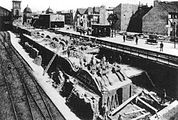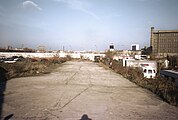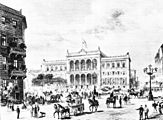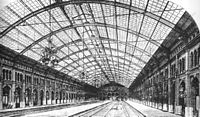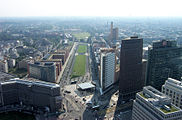Berlin Potsdamer Bahnhof
| Berlin Potsdamer Bahnhof | |
|---|---|
|
Potsdamer Bahnhof from 1872
|
|
| Data | |
| Design | Terminus |
| Platform tracks | 4 Fernbahnhof 4 Ringbahnhof 2 Wannseebahnhof |
| opening | October 29, 1838 |
| Conveyance | February 1945 partly provisional in operation until July 27, 1946 |
| Architectural data | |
| architect | Julius Ludwig Quassowski |
| location | |
| City / municipality | Berlin |
| Place / district | Zoo |
| country | Berlin |
| Country | Germany |
| Coordinates | 52 ° 30 '28 " N , 13 ° 22' 37" E |
| Railway lines | |
| Railway stations in Berlin | |
Berlin Potsdamer Bahnhof was the first train station in Berlin. It was in the city center near Potsdamer Platz . The station was opened in 1838 on the first Prussian railway line. For over a hundred years it served long-distance and suburban traffic. From 1869 to 1872, the terminus station was fundamentally rebuilt and in 1891 two wing stations, the Potsdam Ringbahnhof and the Wannsee station , were added. He lost part of his duties for local traffic in 1939 when the nearby Potsdamer Platz underground station opened in the north-south tunnel . In February 1945, the Potsdam train station went out of service after war damage . After the end of the war , part of the ring station was briefly used again for suburban traffic until 1946. The freight station in front of the passenger station remained partially in operation during the Berlin division. In the meantime, all railway systems and buildings have been removed. On the former station area there are mostly green areas, some also residential buildings.
location
The station was built on the then south-western outskirts of Berlin outside the Berlin customs wall . The station building of the terminus station was south of Stresemannstrasse (until 1930: Königgrätzer Strasse ) not far from Potsdamer Platz . From there, the rail system of the passenger station extended in a south-westerly direction between Linkstrasse and Köthener Strasse as far as the Landwehr Canal .
The station complex belonged to the Mitte district from 1938 to 1972 , but was only connected to the rest of the district via a narrow strip at Potsdamer Platz. The areas bordering on the long sides belonged to the Tiergarten district in the west and to Kreuzberg in the east . Since 1945, the border between East and West Berlin ran on three sides along the boundaries of the station area. After an area swap in 1972, the former area of the passenger station became part of the Tiergarten district . In the early 2000s, the eastern part of the passenger station was built on.
The freight station was in front of the passenger station and was south of the Landwehr Canal in Kreuzberg. To the east of the Potsdam freight yard, the freight yard of the Anhalter Bahn was connected .
The two side stations opened in 1891, the Wannsee station and the Potsdamer Ringbahnhof, were located to the west and east of the main hall at the southern end facing away from the city.
history
The first Potsdam train station
After the section between Zehlendorf and Potsdam of the Berlin-Potsdam Railway, also known as the Stammbahn , went into operation on September 22, 1838 , the section between Berlin and Zehlendorf with the Potsdamer Bahnhof in Berlin followed on October 29. Originally, the Berlin end point of the route was supposed to be in the area of the Schafgraben. However, the station was built in a location closer to the city. It was agreed that future shipping traffic should not be affected. That is why the railway company had to cover the costs of a swing bridge for the overpassing of the railway tracks when the Schafgraben was expanded to become the Landwehr Canal .
From 1850 onwards, the station was connected to the Berlin connecting line , a freight line between Berlin's terminal stations. A track led from this route into the station.
The facilities of the Potsdamer Bahnhof in Berlin were initially very simple, but were gradually expanded until 1868. While in the first years of operation the line was mainly used for passenger traffic, the role of freight traffic grew after the double-track line was expanded in 1846. As early as 1854, the income from freight traffic had exceeded that from passenger traffic, and the space requirement increased accordingly. Until 1854, all passenger and freight traffic was handled on the site north of the Landwehr Canal, only then was a group of tracks to the south of the canal for parking empty wagons.
New building from 1872
However, the expansions made by the end of the 1860s were not enough. It was then decided to fundamentally redesign the railway facilities and equip the station with a completely new reception building. The expansion of Potsdam and, at the same time, that of the neighboring Anhalter Bahnhof was the subject of heated discussion because of its effects on the urban structure, especially after it became apparent that several streets would be interrupted by the railway systems. This also included the general train designed by James Hobrecht and Peter Joseph Lenné , a straight line connection between Charlottenburg and Kreuzberg. As a replacement, a southern road layout was set up in the area of the later Yorckbrücken in the area of the railway systems . A corresponding development plan had already been passed in 1861. However, the area only got its final shape between 1879 and 1885, after the tracks previously laid at ground level were raised so that a crossing-free underpass of the street became possible.
During the construction of the new station, from 1869 to 1872, the passenger and express freight traffic was temporarily relocated to the south side of the Landwehr Canal. On August 30, 1872, Kaiser Wilhelm I officially inaugurated the station, but the construction work was not yet complete at that time. It was not until November 1, 1872 that the new station building actually went into operation.
Due to the renovation of the station, the connecting line in the area of Potsdamer Bahnhof had to be abandoned in 1870. As a replacement, a head station Schöneberg was initially set up provisionally , from which the Potsdamer Bahnhof and the new Berlin Ringbahn could be reached. It was only after several other modifications, including additional track bridges over the Landwehr Canal, that the connecting line to the Ringbahn could be introduced directly into the station hall in 1882. The Schöneberg head station was replaced in 1881 by a new through station roughly at the height of today's Julius-Leber-Brücke stop .
After 1880, the freight yard was expanded and a new 20-hour locomotive shed was built.
The side stations
To cope with the increasing traffic, side stations were built on both sides of the terminus for suburban traffic. On April 1, 1891, the Potsdamer Ringbahnhof on the east side of the station went into operation for the trains to the Ringbahn, on October 1 of the same year the Wannsee station followed on the west side, together with the construction of a separate suburban line parallel to the long-distance tracks of the main line, the so-called New Wannseebahn .
In 1901 the Anhalter Vorortbahn was opened, which began in the Potsdam Ringbahnhof, which is why in some texts it was also referred to as the Ring- und Vorortbahnhof . The Ringbahnhof received an extension this year.
On June 4, 1903, the Anhalter suburban railway between Potsdamer Bahnhof and Groß Lichterfelde began operating electric trains on a trial basis. In the same year, the banker's trains were introduced on the Wannsee Railway , accelerated suburban trains to Wannsee, which began in the Potsdam long-distance train station and ran on the long-distance tracks to Zehlendorf. On April 18, 1929, electrical operation began on the Südringspitzkehre to the Ringbahn, the Anhalter suburban railway was converted to the uniform power system of the Berlin S-Bahn in the same year . Electrical operation for the suburban trains on the Wannseebahn started on May 15, 1933. Two tracks in the long-distance station were also provided with a conductor rail for the banker's trains running on the long-distance tracks.
During a regional reform in 1938, the area of the passenger station, which was previously in the Kreuzberg district, became part of the Mitte district .
In 1939, with the completion of the north-south tunnel, a continuous S-Bahn connection under Berlin's inner city was put into operation. Since then, most of the S-Bahn trains have been running through the tunnel and instead of the Potsdamer Bahnhof they drove to the new Potsdamer Platz tunnel station . The Wannsee railway station was no longer needed for passenger traffic and closed on October 8, 1939. From November 6, 1939 the suburban traffic of the Anhalter and Dresdener Bahn was also relocated to the tunnel. The Potsdam Ringbahnhof remained in operation for the trains to the Ringbahn.
Second World War and consequences
With bombing raids in World War II, Potsdamer station was badly damaged. From July 3, 1944, traffic on the Südringpitzkehre to the Ringbahn was stopped, and in February 1945 the Potsdamer Bahnhof was completely closed to passenger traffic. After the north-south tunnel was flooded at the end of the war, the ring station went into operation again for a few months from August 6, 1945 for the Wannsee Railway trains. On July 27, 1946, however, passenger traffic finally ended.
With the increasing separation of the Berlin halves, there was no need to rebuild the station facilities. Only the freight yard remained in operation. The ruin of the station building of the passenger station was demolished in 1958.
When the Berlin Wall was built, the grounds of the Potsdam passenger train station belonging to East Berlin were not included in the border security measures and lay as a no man's land on the west side of the wall. In June 1972, the area including the underground sweeping system south of the Potsdamer Platz subway station was officially part of West Berlin as part of an area swap , but remained under the responsibility of the Deutsche Reichsbahn and remained undeveloped until after 1990. After 1972, a road connection was built in the extension of Bernburger Strasse across the grounds of the Potsdam train station to the relief road.
On November 1, 1980, traffic to the Potsdam freight yard was stopped and the station closed. The area of the freight yard was used by small businesses. In the second half of the 1980s, a black market , the so-called “Poland Market”, settled on the wasteland of the former passenger station .
In the 1990s, part of the Potsdam freight yard was served by trains again, as the construction logistics for the new construction of Potsdamer Platz were based there and building materials were delivered by rail. The former locomotive shed at the station was demolished for the required concrete plant.
In the course of the development of the areas around Potsdamer Platz, residential buildings were built on the eastern part of the former passenger station area, while the Tilla-Durieux-Park was built in the western part . As part of the mushroom concept for the redesign of the Berlin railway system, a new axis through the inner city of Berlin, the north-south long-distance railway , which runs partially underground, was created by 2006 . The southern exit of the north-south long-distance railway tunnel is on the site of the former Potsdam freight station.
The Westpark , part of the park at Gleisdreieck , on the freight yard area was opened in May 2013.
Location of the former Potsdam Ringbahnhof, view towards Leipziger Platz , 1986
The route of the M-Bahn runs over the former station area, 1988
passenger traffic
The main purpose of the station was to serve traffic to the west. With the completion of the Berlin-Lehrter Railway at the beginning of the 1870s, some of the trains moved to Hanover and further west on this route. After the completion of the Berlin Stadtbahn and the Wetzlarer Bahn there was also a possibility to travel from the Stadtbahn in the direction of Magdeburg, but most of the long-distance train services in this relation remained at the Potsdam train station. This also included the first German express train , the D 31/32 (Cologne – Berlin), introduced in 1892 .
Mainly, however, the Potsdam train station was used for suburban traffic. Most of the suburban traffic shifted to the two side stations after 1891. From the long-distance station, the steam-powered suburban trains ran on the main line to Potsdam and Werder (Havel) . The accelerated banker trains introduced in 1903 also used the long-distance train station.
In 1934, depending on the season, ten or eleven pairs of express and express trains ran from the long-distance station to Magdeburg and on to Cologne , Wiesbaden or Frankfurt (Main), among others , as well as a few passenger trains . In addition, there were hourly suburban trains to Werder (supplemented by additional trains at peak times) and the "banker's trains" from Wannsee for early work and back in the afternoon.
From the Wannseebahnhof the S-Bahn trains of the Wannseebahn left every ten minutes, at peak times every five minutes on weekdays.
Electric trains ran from the Ringbahnhof to the Ringbahn and on the Anhalter Vorortbahn to Lichterfelde Ost, every 10 minutes on both routes at most times of the day. There were also suburban trains on the Dresden Railway to and from Rangsdorf, Zossen or Wünsdorf. These trains were still operated with steam until 1939, and electrical operation on this route only began a few months before the north-south tunnel was completed.
Investments
The first Potsdam train station
The first Potsdam train station had a main track in the field with a platform. There was a rail car hangar on the platform track. In addition, two installation tracks were connected to the east. To the west of the tracks was the station building with a covered forecourt and “rooms” for the passengers and a room for the royal court. The building was a 51.5 meter long three-story structure with arched arcades. This arcade led around the facility on three sides. In front of the building was a "rail car hall" with a platform and a track. A roof terrace, which is part of the platform management, was located above the platform hall. From 1846 to 1848 the building was rebuilt and a platform three times as long was created instead of the short hall. Arcades offered weather protection. The freight handling has been enhanced so that in 1854 was little to see from the original station shape.
After the renovation
The new Potsdamer Bahnhof, inaugurated in 1872, had four tracks with two side and one middle platform and a fifth track for locomotives or for parking trains. The tracks lay in a 172-meter-long and 36.6-meter-wide hall that was surrounded on three sides, the front was 67.5 meters wide and the side panels 205 meters long. The brick entrance building was faced with Greppin bricks . The head building was symmetrical, with two side buildings, a larger west wing and a smaller east building. The latter essentially only housed rooms for the imperial rulers. In the western part of the station there were not only the ticket offices but also waiting rooms for all four classes. The street-side facade was decorated with round arches and had a medium risalit . A flight of stairs led from Potsdamer Platz into the reception building.
The platform hall had a roof construction made of sheet metal floor beams with a box cross-section and was almost completely glazed. The design came from chief engineer Schmidt.
Both side stations were built at the end of the side development of the long-distance station, so they were significantly further away from today's Stresemannstraße compared to the long-distance station. The Wannseebahnhof had a platform with two platform edges, the ring and suburban stations after the expansion at the beginning of the 20th century one platform each for the ring and suburban trains. The two side stations were connected by a tunnel that ran under the southern part of the long-distance platforms.
The area of the freight yard was south of the Landwehr Canal and reached just before Yorckstrasse . In relation to its location to the line and to the city, it was also called the outer station , while the passenger station was the inner station . Overall, the passenger and freight station facilities stretched from today's Stresemannstrasse to Yorckstrasse over a total length of around two kilometers.
The loading facilities of the freight yard, two loading lanes and two freight halls to the west of it, could be reached from Schöneberger Ufer. To the south of this complex were the shunting systems and in the south-eastern part of the station complex the railway depot with a roundhouse and other treatment systems. Above the freight yard area, two elevated railway lines run on a viaduct, today's underground lines U1 and U2 .
Potsdamer Bahnhof as seen from Potsdamer Platz, drawing by Gottlob Theuerkauf
Cemetery on the station forecourt
Until the early 1920s, there was a Trinity Cemetery in the forecourt of Potsdamer Bahnhof. The burial site, which was laid out around 1740, seemed increasingly isolated and out of place in the hustle and bustle of Potsdamer Platz. When the first Potsdam train station was built, the railway company financed a wall up to eight feet high that surrounded the Trinity cemetery from 1837. The left half of the facade of the reception building, which was newly built in 1870–1872, rose only a few meters from the cemetery. It was not until 1909 that the cemetery was finally closed for new burials and a few years later the area was sold to the Royal Railway Directorate for 600,000 marks (adjusted for purchasing power in today's currency: around 3.26 million euros). In 1914, the company announced a competition for the uniform redesign of the station forecourt, which gave the architects plenty of scope for suggestions. Due to the war, the competition was not concluded until 1919. However, none of the 78 submitted designs was ultimately implemented. In 1922 it was limited to removing the cemetery wall, leveling the graves and converting the cemetery grounds into a simple green area.
Todays situation
The station's high-rise buildings are no longer preserved. The eastern part of the former passenger station area along Köthener Straße is built on, and the Park Kolonnaden was built there between 2000 and 2002 . The Tilla-Durieux-Park was laid out in the western part beyond the newly built Gabriele-Tergit-Promenade . Westpark , part of the park at Gleisdreieck, is located on the former site of the freight yard south of the Landwehr Canal and its riverside streets . Part of the route of the north-south long-distance line runs in the south-eastern part of the freight yard . At the end of 2014, the demolition of a surviving viaduct section of the Südringspitzkehre in the area of the Gleisdreieck underground station began .
Left the disused viaduct of the ring road on gleisdreieck , 1986
Westpark of the Park am Gleisdreieck on the site of the freight station with the viaduct of the U1 underground line , view towards Potsdamer Platz
literature
- Peter Bley: 150 years of the Berlin – Potsdam railway . Alba, Düsseldorf 1988, ISBN 3-87094-221-5 .
Web links
Individual evidence
- ^ Berlin and its railways 1846-1896. Published by the Ministry of Public Works, Julius Springer Verlag, Berlin 1896, reprint Verlag Ästhetik und Kommunikation, Berlin 1982, p. 141.
- ↑ a b Günter Kühne, Fern- und S-Bahnhöfe , in: Berlin and his buildings, Volume B, systems and buildings for traffic, (2) Fernverkehr , Ernst and Son, publishing house for architecture and technical sciences, Berlin 1984, ISBN 3-433-00945-7 , pp. 26-28.
- ↑ a b c d The construction of the Wannseebahn and the redesign of the Potsdamer Bahnhof in Berlin, I. Development of the Potsdamer Bahn up to the construction of the Wannseebahn . In: Zeitschrift für Bauwesen , Volume XLIII (1893), pp. 421–431. Digitized in the holdings of the Central and State Library Berlin .
- ↑ a b c d e Jürgen Meyer-Kronthaler, Wolfgang Kramer: Berlin's S-Bahnhöfe / A three-quarter century . be.bra verlag, Berlin 1998. ISBN 3-930863-25-1 , pp. 228-230
- ↑ Wolfgang Klee: From after 99 years. The oldest express train in Germany will soon no longer run. in: Eisenbahn Magazin 3/91, p. 16, ISSN 0342-1902 .
- ↑ Peter Güttler, List of Buildings and Systems for the Railway , in: Berlin and his Buildings, Volume B, Systems and Buildings for Traffic, (2) Fernverkehr , Ernst and Son, Verlag für Architektur und Technische Wissenschaften, Berlin 1984, ISBN 3-433-00945-7 , p. 138
- ↑ a b c d e Manfred Berger , Historische Bahnhofsbauten, Vol. 1, Saxony, Prussia, Mecklenburg and Thuringia , Transpress-Verlag (1980), pp. 138–143.
- ↑ Peter Güttler, List of Buildings and Systems for the Railway , in: Berlin and his Buildings, Volume B, Systems and Buildings for Traffic, (2) Fernverkehr , Ernst and Son, Verlag für Architektur und Technische Wissenschaften, Berlin 1984, ISBN 3-433-00945-7 , pp. 141-142.
- ^ Hans-Jürgen Mende : Lexicon of Berlin burial places . Pharus-Plan, Berlin 2018, ISBN 978-3-86514-206-1 , pp. 152–153.
- ↑ Zentralblatt der Bauverwaltung , number 31. 34th vol., April 18, 1914, ISSN 0372-8021 , p. 247.
- ^ Mende: Lexicon of Berlin burial sites . P. 152.
- ↑ News in brief - S-Bahn . In: Berliner Verkehrsblätter . February 2015, p. 30 .






